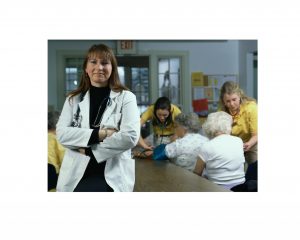Dr. Mauk’s Boomer Blog
Each week, Dr. Kristen Mauk shares thoughts relevant to Baby Boomers that are aimed to educate and amuse.
Dr. Kristen L. Mauk, PhD, DNP, RN, CRRN, GCNS-BC, GNP-BC, FAAN

Assisted Living: 7 Answers to Common Questions
What is assisted living (AL)?
A Scandinavian model for senior care, now known as assisted living, made its way into America’s care system in the 1980’s. According to a 2012 report by AARP, there is no standard definition for assisted living (AL). Although individual states and residential facilities can give their own definition of AL, the term most often means that help is provided with meals, social support, medications, dressing and/or bathing and the like with 24-hour per day supervision. The Assisted Living Federation of America (ALFA) (2013) defines assisted living as “a long-term care option that combines housing, support services and health care, as needed”. The focus of AL is on maintaining dignity, respect, and independence of older residents.
In 2010, there were more than 51,000 licensed residential care settings (including assisted living) that reported more than 1.2 million beds (AARP, 2012). A study published by the National Center for Assisted Living (NCAL) cited 31,100 assisted living facilities serving 733,400 persons in 2010.
What is the typical assisted living resident like?
The average age of those in assisted living facilities is 86.4 years (MetLife, 2012). According to the National Center for Assisted Living (2013), the typical resident needs help with at least one activity of daily living (ADL), and most are over the age of 85. More females (76%) live in assisted living settings than males (26%). Thirty-seven percent of persons in AL receive help with more than three ADLs (NCAL, 2012). More than half of persons in AL facilities have some type of cognitive impairment (Alzheimer’s Association, 2009). A growing percentage of persons in AL facilities have Alzheimer’s disease.
What types of services are provided?
Some of the usual services provided in a licensed AL include:
• Assistance with eating, dressing, bathing, toileting
• Access to health services
• Medication management
• Dining services
• 24 hour staffing and security
• Emergency call systems
• Exercise and wellness facilities
• Social and recreational activities
• Housekeeping and laundry
• Transportation
• Access to banking
• Chaplain or religious services
• Memory care
How do I know if I need assisted living?
There are a variety of reasons why persons might choose an assisted living setting. Some people move to AL because they want more socialization than living alone, they want to be nearer to their adult children but do not reside with them, or because they can no longer manage at home. The person in an assisted living facility generally needs some help with activities of daily living, but does not need skilled nursing care. So, AL might be right for you if you wouldn’t be able live at home any longer without help, but you still don’t need to be in a nursing home or need the help of a nurse around the clock. You may be able to do many things on your own but maybe you have difficulty with dressing, meal preparation, or managing your pills.
How do I decide which senior living community to choose?
There are a variety of senior living options, of which assisted living is but one. Often, family members will help you decide which option is best for you, but you should look at all your choices. You should pick a place that offers the services that you need. Cost and location are additional considerations. It is also good to ask about the staffing ratios, what nursing care is available, and what happens if you later need a higher level of care than the AL provides. ALFA provides a Guide to Choosing an Assisted Living Community. This includes a helpful checklist that can be downloaded from their website.
How much does it cost to live in an AL facility?
The cost of AL depends on where you live. Keep in mind that most assisted living is paid for privately, meaning out-of-pocket, and not by insurance. According to MetLife’s Market Survey of Long-term Care Costs (2012), the national average base rate for assisted living was $3,550 per month. This means that a person who lives in an assisted living facility can expect to pay an average of $42,600 per year. Of course this also varies depending on the number of extent of services with which the resident needs help. The base rate generally includes specific services, but each additional service beyond that may add an extra monthly fee. Compare this to an average nursing home rate for a shared room at nearly $84,000 per year for a person needing Alzheimer’s care (MetLife, 2012) or a national median cost of $270 per day in a nursing home that provides 24-hour per day nursing care (Genworth Cost of Care Survey, 2013).
Are there alternatives to assisted living facilities?
So, are there other options besides going to an assisted living facility if you are an older adult who needs a little help? The answer is yes. Adult day services are one community option. Also, many home care agencies offer companions, homemaker aides, or nursing assistants to help people age in place at home. Most of the time, getting these services means a minimum number of hours per day must be paid for. The national average hourly rate for home health aides was $21 in 2012. Homemaker or companions who provide “hands-off” care such as running errands, shopping, housekeeping made a median of $19-20 the same year (Genworth, 2013).
This is where unique options for assisted living services at home are needed and can save consumers money. Senior Care Central offers persons needing assisted living in the home the opportunity to have more control over their care situation at a much lower cost while getting professional, quality care. Imagine that you could set the hours that you want to have a caregiver in the home, and that caregiver could be a nursing student who has a higher level of education than most home health aides. This care option may cost you half the price charged by a home health care agency. SCC’s model promotes aging in place on your own terms and lets you link with caregivers online, browse profiles to choose caregivers you want to contact, and make your care arrangements directly with them.
Guest Blog: Bringing the family support together – Crucial steps in elder care planning

As a devoted caregiver for an aging parent, you have to be ready to face a wealth of new responsibilities. Some of them will be intimidating, whereas others will be unfamiliar and unforeseen. Every now and then, you may feel alone and overwhelmed. However, in spite of all these challenges, caring for an aging parent comes with plenty of rewards too. There are many guidelines you should consider to make the process run smoother. Here are some steps to consider.
Bring the whole family together decide on a caregiving plan
Before making any decisions, you should set up a family meeting and decide with your siblings what’s best for your parent. Should you hire a home care assistant for your parent, or would it be better to put them in respite care home? If your parents are mentally stable but are having difficulties remembering things, or heading out to shop for groceries, you and your siblings may be able to be their caregivers. Split tasks equally by making a weekly plan. This way, your parents get the chance to see their kids, and you won’t have to get angry that nobody else but you in the family is looking after the parents.
Split responsibilities equally
Proper elder care takes a lot of time and effort. Careful planning is fundamental for your parents to live happy and not feel like a burden. Always remember that providing care for a loved one is an act of love, loyalty, and kindness. Thanks to advanced technology, it is now easier than ever to keep in touch with aging parents. Medical treatments are improving, life expectancy’s are increasing, and seniors are living well into their 70s. If you know little about caregiving, follow the tips below to provide the best care for your elder parent:
- Learn everything there is to know about their disability or illness. This will help you be prepared in case something unexpectedly happens.
- Look for professional help from certified caregivers.
- Go with your gut, and listen carefully to a doctor’s advice. If they tell you that an assisted living facility is better for your loved one, then they’re probably right.
Elder parents will do anything to preserve their independence, even if it means living on their own with a chronic illness or disability. Don’t allow them to struggle and try to make their lives more comfortable by caring for their well being.
The 6-Step Process of Stroke Recovery
According to the CDC, nearly 800,000 persons in the United States have a stroke each year. This is about one every 4 minutes, resulting in over 130,000 deaths annually. Stroke is simply defined as an interruption to the blood supply to the brain and is caused by a clot or hemorrhage. It can be a devastating problem for survivors, resulting in changes in mobility, cognition, speech, swallowing, bowel and bladder, self-care, and general functioning to varying degrees. Some people recover completely after a stroke, but others experience lifelong challenges.
The good news is that there is hope and quality of life after stroke. In my research with stroke survivors, I discovered 6 phases that survivors reported as they made the journey through rehabilitation towards recovery. These steps can be used to see where a person is in the recovery process, help us understand how they may be feeling, and help guide the way we interact with them.
Agonizing: In this first phase of the process, stroke survivors are in shock over what has happened to them. They can’t believe it, and may even deny the warning signs of stroke. The important task during this time is survival from the stroke itself. Call 911 if you see the warning signs of facial droop, arm weakness, or speech difficulties.
Fantasizing: In the second phase of the stroke process, the survivor may believe that the symptoms will all go away. Life will return to normal, and there is a sense of the problem being unreal. Time takes on a different meaning. The way to help is to gently help them recognize reality, and without taking away hope for recovery.
Realizing: This is the most important phase that signals a turn in the recovery process. This is when the survivor realizes that he/she may not fully recover from the effects of the stroke and that there is work to be done to rehabilitate and reclaim life. Common feelings during this phase of realizing are anger and depression. The way to help is to encourage the person to actively engage in rehabilitation. The real work of recovery is just beginning.
Blending: These last 3 phases in the process of stroke recovery may be occurring at much the same time. This is where the real work of adaptation to life after stroke begins. The survivor begins to blend his “old life” before stroke with his new life as a stroke survivor. He/she may start to engage in former activities even if it requires adaptations to be made. He/she will be actively engaged in therapy and finding new ways to do things. The way to help is to promote education. This is a time when survivors are most ready to learn how to adjust to life after stroke. Listen to your rehab nurses, therapists, and physician. Be active in the recovery process.
Framing: During this phase, the individual wants to know what caused the stroke. Whereas in the Agonizing phase they were asking “why me?”, now they need to the answer to “what was the cause?” Stroke can be a recurring disorder, so to stop a subsequent stroke, it is important to know the cause. Interestingly, if the physician has not given the survivor a cause for the first stroke, patients often make up a cause that may not be accurate. Help the survivor to learn from the health care provider what the cause of his/her own stroke was. Then steps can be taken to control those risk factors.
Owning: In this final phase of stroke recovery, the survivor has achieved positive adaptation to the stroke event and aftermath. The survivor has accomplished the needed grief work over the losses resulting from the stroke. He/she has realized that the effects may not go away and has made positive adjustments to his/her life in order to go on. Survivors in this phase have blended their old life with the new life after stroke and feel better about their quality of life. While they still may revisit the emotions of the prior phases at times, they have accepted life as a survivor of stroke and made good adjustments to any changes that resulted. They feel that they have a more positive outlook on life. At this point, survivors can use their experience to help others cope with life after stroke.
For more information about stroke recovery, visit www.seniorcarecentral.net and view Dr. Mauk’s model for stroke recovery.
Guest Blog: Tips on Caring for Loved Ones with Dementia
Dementia is a chronic or progressive syndrome that affects a person’s thinking, memory, comprehension, orientation, language, learning capacity, judgment, and calculation. People with dementia slowly lose their cognitive abilities, which leads to a decline in their social behavior and emotional control. Dementia develops when the brain is injured or damaged, such as what happens to individuals with Alzheimer’s disease.
According to the Alzheimer’s Association, over five million Americans are currently dealing with Alzheimer’s dementia. An estimated 80% are seniors aged 75 and up. If proper care, attention, and medication are not prioritized, the total can balloon to 13 million by 2050. Medical and health facilities are doing every means possible to address the situation.
If your senior family member has dementia and living at home or is under assisted living care, your best contribution is to care for your loved one properly. Here are tips to help you out.
Ask simple questions.
Someone with dementia will find open-ended questions confusing and intimidating. Instead of asking “what” questions, try to rephrase them to “yes-no” questions. For example, instead of asking, “What time would you like to take a bath today?” try asking, “Would you like to take a bath at 4 pm?”
Keep your words simple and clear.
Allow your loved one to help with daily tasks.
When dementia progresses, your loved one may find it difficult to remember and focus on tasks. You can help him or her maintain daily activities and skills and stay active. Allow him or her to assist you with simple activities such as setting the table, making the bed, and gardening. Help your loved one remember tasks and things by placing memory aids, such as signs and labels, all over the house.
Take your loved one to lunch.
Keeping senior loved ones with dementia socially active is essential. Have lunch together at his or her favorite restaurant. Go to a place where he or she used to frequent when communication wasn’t yet a problem. Make your loved one feel special and important.
Hold and touch your loved one.
Your touch is very powerful and reassuring. Hold your loved one’s hand or stroke his or her face now and then. Let him or her feel your love and support.
Most important of all, ask for help. Talk to a caregiver or get in touch with an assisted living care facility.
About the Author
Melissa Andrews is the Content Marketing Strategist for Paradise Living Centers, an assisted living center for seniors with locations in Paradise Valley and Phoenix, Arizona. In her spare time, she enjoys cooking and going on hiking trips with her siblings and cousins.
Essential Tools for Seniors with Parkinson’s
If you or someone you care for has Parkinson’s disease, you may encounter a wide array of symptoms on a day to day basis from tremors to muscle rigidity to slowed movements, balance problems, and speech changes. Non-physical symptoms can accompany the disease as well including trouble sleeping, mood changes, urinary urgency, constipation, even loss of smell.
When it comes to managing this type of chronic autoimmune condition, in addition to a comprehensive treatment planned laid out by your doctor, assistive equipment can go a long way in simplifying daily life:
Adaptive Utensils
Advancements in science and technology have made their way into the kitchen market providing relief to people who may otherwise have difficulty feeding themselves. Adaptive utensils are specially designed to help counteract tremors someone with Parkinson’s may have in their hand when holding a fork or spoon, for example.
Other helpful dining aids may include weighted cups and bowls (that are less likely to tip over), and plate guards or high-rimmed plates that prevent food from falling out.
Bedroom Equipment
People with Parkinson’s are at increased risk of falling so supportive equipment around the bed can definitely make this fall-prone environment safer. Install bed rails to aid seniors with limited mobility or try a super pole that stands fixed beside the bed or a pull strap that connects to the end of the bed and makes it easier to sit up.
Bedside commodes can also simplify the task of night time toileting, especially for Parkinson’s sufferers with incontinence issues.
Dressing Aids
As dexterity and finger nimbleness falls prey to the contracture of muscles and joints in the hands, getting dressed on your own can become difficult. This key marker of independence may be retained in some respects with dressing aids that allows a person with Parkinson’s to dress themselves. Tools like button hooks, zipper pulls, one-handed belts, dressing sticks, and shoe horns can all go a long way to promoting self-reliance even as the disease progresses.
Bathing Tools
Maintaining personal hygiene has the ability to improve your sense of confidence and your mood, no matter what Parkinson’s brings your way. Equipment that makes bathing safer and reduces the risk of falling includes shower transfer chairs, grab bars (inside and outside the shower), and non-slip bath mats. Additional bathroom tools may include weighted holders for toothbrushes, razors, etc. as well as removable shower heads and long-handled bath sponges and scrubbers.
The Role of the Rehabilitation Nurse
You may have heard of rehabilitation nursing, but are you familiar with what rehabilitation nurses do and their essential role in health care? According to the Association of Rehabilitation Nurses (ARN), there are four major domains within the new competency model for professional rehabilitation nursing (ARN, 2016) that can help us understand what rehabilitation nurses do. In this blog, we will look at the ARN model from a layperson’s viewpoint to help explain the role of the rehabilitation nurse. Rehabilitation nurses:
Promote successful living
Rehabilitation nurses do not only care for people, but they promote health and prevent disability. This means that rehab nurses engage in activities that help patients, families and communities stay healthy. Proactively, you might see rehab nurses helping with bike safety (such as promoting the wearing of helmets), car seat fairs (to keep children safe from injury), or stroke prevention through community screenings and teaching about managing risk factors. As rehab nurses, we also help patients towards self-management of existing chronic illness or disability, teaching them how to be co-managers with their health providers so they can maintain independence and have a good quality of life. Another key activity is facilitating safe care transitions. This means that rehabilitation nurses have a special skill set to know which setting of care is best for the patient to move to next and how to make this happen smoothly. For example, if Mrs. Smith has had a stroke and finished her time in acute rehabilitation in the hospital, but she lives alone and is not quite ready to go home, what is the best care setting or services for her to receive the help she needs? Many errors, such as those with medications, happen when patients go from one place to another in the health system. Rehabilitation nurses can help persons successfully navigate these complexities and be sure that clients get the continuity of care they need and deserve.
Give quality care
The interventions or care that rehabilitation nurses provide to patients and families is based on the best scientific evidence available. Part of being a rehab nurse is staying current on the latest technology, strategies for care, and best practices. This is to ensure that all patients receive the highest standard of care possible. We stay current in many ways, including reading journal articles, attending conferences, obtaining continuing education, and maintaining certification in rehabilitation. Research shows that having more certified rehabilitation nurses on a unit decreases length of stay in the hospital. In addition, all of rehab care focuses on the patient and family as the center of the interdisciplinary team. To this end, rehabilitation nurses teach patients and families about their chronic illness or disability across many different areas including: how to take medications; managing bowel and bladder issues; preventing skin breakdown; dealing with behavioral issues that might be present with problems such as brain injury or dementia; coping with changes from a disabling condition; sexuality; working with equipment at home; and ways to manage pain.
Collaborate with a team of experts
Rehabilitation nurses are part of an interprofessional team of physicians, therapists, psychologists, nutritionists, and many others who work together for the best patient outcomes. For persons who have experienced a catastrophic injury or illness, the work of this team of experts sharing common goals will provide the best care, and rehab nurses are the ones who are with the patient 24/7 to coordinate this process. Through effective collaboration, excellent assessment skills, and communication with the rest of the team members, rehab nurses ensure that patient and families are getting well-coordinated care throughout the rehabilitation process. Remember that rehabilitation takes place in many settings, whether on the acute rehab unit, in skilled care, long-term care, or the home. The nurse’s role is to be sure that the holistic plan of care is followed by all staff and that the physicians overseeing medical care are continually informed of patient progress for the best decision-making possible.
Act as leaders in rehabilitation
Not only do rehabilitation nurses provide direct patient care, they are also leaders in the rehabilitation arena. You might be surprised to learn that rehabilitation nurses advocate at the highest level for legislation surrounding funding and policy for those with disabilities and chronic illness, talking with Senators and Congressmen about key issues. ARN has professional lobbyists that continually watch health policy movement in Washington and keep rehab nurses informed. Rehab nurses help patients to advocate for themselves in holding government and communities accountable for needed care services. Lastly, rehab nurses share their knowledge with others. This is done in a variety of ways through conducting and publishing research, presenting at conferences, serving on local and national committees, and serving in public office. All of the leadership activities done by nurses in rehabilitation are to promote the best quality of care for patients with chronic illness and disability.






